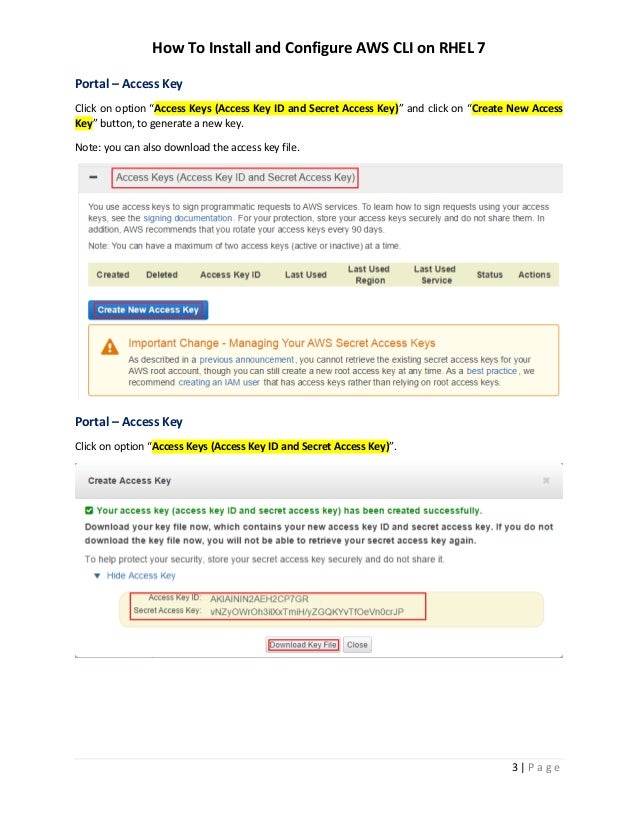Generate Access Key And Secret Key Aws Cli
To create access keys for your AWS account root user, you must use the AWS Management Console. A newly created access key has the status of active, which means that you can use the access key for CLI and API calls. AWS Access Keys. Access Keys are used to sign the requests you send to Amazon S3. Like the Username/Password pair you use to access your AWS Management Console, Access Key Id and Secret Access Key are used for programmatic (API) access to AWS services. You can manage your Access Keys in AWS Management Console. In order to get your Access Key ID and Secret Access Key follow next steps: Open the IAM console. From the navigation menu, click Users. Select your IAM user name. Click User Actions, and then click Manage Access Keys. Click Create Access Key. Your keys will look something like this: Access key ID example: AKIAIOSFODNN7EXAMPLE.

The crew beta key generator download. [ aws . iam ]
If the secret is in a different AWS account from the credentials calling an API that requires encryption or decryption of the secret value then you must create and use a custom AWS KMS CMK because you can't access the default CMK for the account using credentials from a different AWS account.
Description¶
Jul 21, 2018 Download the Key pairs to your system for future use. Click on Show Access key and you will get your Access Key ID and Secret Access Key. You need to use this Access Key ID and Secret Access Key to. An access key grants programmatic access to your resources. This means that the access key should be guarded as carefully as the AWS account root user sign-in credentials. It's a best practice to do the following: Create an IAM user and then define that user's permissions as narrowly as possible. Create the access key under that IAM user.
Creates a new AWS secret access key and corresponding AWS access key ID for the specified user. The default status for new keys is Active .
If you do not specify a user name, IAM determines the user name implicitly based on the AWS access key ID signing the request. This operation works for access keys under the AWS account. Consequently, you can use this operation to manage AWS account root user credentials. This is true even if the AWS account has no associated users.
For information about limits on the number of keys you can create, see Limitations on IAM Entities in the IAM User Guide .
Cisco crypto key generate rsa general-keys modulus 2048. Warning
To ensure the security of your AWS account, the secret access key is accessible only during key and user creation. You must save the key (for example, in a text file) if you want to be able to access it again. If a secret key is lost, you can delete the access keys for the associated user and then create new keys.
See also: AWS API Documentation
See 'aws help' for descriptions of global parameters.
Synopsis¶
Options¶
--user-name (string)
The name of the IAM user that the new key will belong to.
This parameter allows (through its regex pattern ) a string of characters consisting of upper and lowercase alphanumeric characters with no spaces. You can also include any of the following characters: _+=,.@-
--cli-input-json (string)Performs service operation based on the JSON string provided. The JSON string follows the format provided by --generate-cli-skeleton. If other arguments are provided on the command line, the CLI values will override the JSON-provided values. It is not possible to pass arbitrary binary values using a JSON-provided value as the string will be taken literally.
--generate-cli-skeleton (string)Prints a JSON skeleton to standard output without sending an API request. If provided with no value or the value input, prints a sample input JSON that can be used as an argument for --cli-input-json. If provided with the value output, it validates the command inputs and returns a sample output JSON for that command.
See 'aws help' for descriptions of global parameters.
Examples¶
To create an access key for an IAM user
The following create-access-key command creates an access key (access key ID and secret access key) for the IAM user named Bob:
Output:
Store the secret access key in a secure location. If it is lost, it cannot be recovered, and you must create a new access key.
For more information, see Managing Access Keys for IAM Users in the Using IAM guide.
Output¶
AccessKey -> (structure)
A structure with details about the access key.
UserName -> (string)
AccessKeyId -> (string)
Status -> (string)
SecretAccessKey -> (string)
Get Access Key And Secret Key Aws Cli
CreateDate -> (timestamp)